 Help Wanted:
Help Wanted:
1. Mistake correction
2. Drawing illustrations in vector
Mistake in the text? Select it and click CTRL + ENTER
 Help Wanted:
Help Wanted:
1. Mistake correction
2. Drawing illustrations in vector
Now we car dose our investigation of the physics aspects of electrical play with a short look at some basic electrical devices – transformers and capacitors. You’ll find both such devices in many of our favorite electrical toys such as TENS units, violet wands, and relaxacisors. Looking at the theory of capacitors can help us understand the operation of toys like the Carpet Shuffle Zap and the violet wand.
You’ll find transformers all over the place. They Ye Devices in televisions, in your doorbell, all over the electrical power company, etc. To study them and understand them as electrical engineers do takes a study of electromagnetism and a lot of math. Understanding transformers for electrical play just takes the following five rules.
 Transformers take a voltage at one end (the “primary”) and transform it to a higher or lower voltage at the other end (the “secondary”).
Transformers take a voltage at one end (the “primary”) and transform it to a higher or lower voltage at the other end (the “secondary”).Transformer Rule #1:
All transformers do is to take a voltage in at one side of the transformer, called the primary, and change it to a higher or lower or sometimes even the same voltage at the other side of the transformer, called the secondary.
Transformer Rule #2:
Transformers work by changing primary voltage. Transformers are generally used with AC (alternating current). But this change can even be done with DC – like from a battery – as long as something changes, i.e., when the battery is switched from OFF to ON or from ON to OFF when connected to the primary. In this case what you’ll get at the secondary is a little blip of (higher, lower, the same) voltage, A blip, but a voltage nonetheless.
Transformer Rule #3:
The ratio of a transformer’s secondary voltage to primary voltage is called the transformer ratio, or
transformer ratio = secondary voltage / primary voltage
or,
transformer ratio = primary current / secondary current
If the transformer ratio is greater than one, then the transformer is called a stepup transformer.
If the transformer ratio is less than one t then the transformer is called a stepdown transformer.
Transformer Rule #4:
If you have a transformer where the secondary voltage is greater than the primary voltage, then the secondary currents are less than the primary currents. This follows from the transformer ratio in Transformer Rule No. 3. For example if you have such a transformer with a transformer ratio of 10, then 10 volts at 10 amps at the primary will show 100 volts at I amp at the secondary. If the trans- former ratio is 0.1, then 100 volts and I amps at the primary will show 10 volts and 10 amps at the secondary.
Transformer Rule #5:
Sometimes transformers are used to isolate circuits. This means that with some transformers, the circuit connected to the secondary side is not wired to the circuit on the primary side. All the rules still apply, but – as an example – if the primary side were grounded, the secondary side wouldn’t be, Note, however, that not all transformers work like this – and even with isolation transformers, this isolation may only be for certain frequencies (like the household frequency of 60 Hz).
If you’re interested in finding out more about transformers, you should consult some of the books on electricity or electronics in the Bibliography.
In electrical toys, transformers are used mostly for providing power to the toy. This is what the transformer is used for in a relaxicisor. In a violet wand, however, the transformer is a special type called a Tesla coil that produces the high voltages needed to make the gas bulbs – and subsequently the bottom – glow.
This is one question you’re probably asking yourself. You’re probably thinking about the adapter that you can get to plug into a household outlet and provide a low voltage DC so that you can run your portable electronic gear without using batteries. You say, “You convert from high voltage to low voltage – a stepdown transformer right? But isn’t a transformer only supposed to be for AC?”
Well, you’re partly right and partly wrong.
Most DC adapters sold in electronic stores do convert 120 volt AC to low voltage DC, There are two kinds of DC adapters. The kind that uses a transformer converts 120-volt AC to low-voltage AC, then passes that through an electronic device called a rectifier (or a diode) that changes AC to DC (but not the other way around). The changing of a high voltage to a low voltage can also be done with electronic circuits, rather than with a transformer. It’s just that for large amounts of AC power, transformers are more convenient.
I’m going to have to take a little of your time to explain the theory behind capacitors. Bear with me, please, because this theory will also help you understand how a violet wand works.
First off, a capacitor consists of two or more conducting plates on opposite sides of an insulator. The insulator can be a sheet of insulating material such as plastic or wax, or a space of gas such as air, or even a vacuum. You’ll see the basic parts in figure 18A.
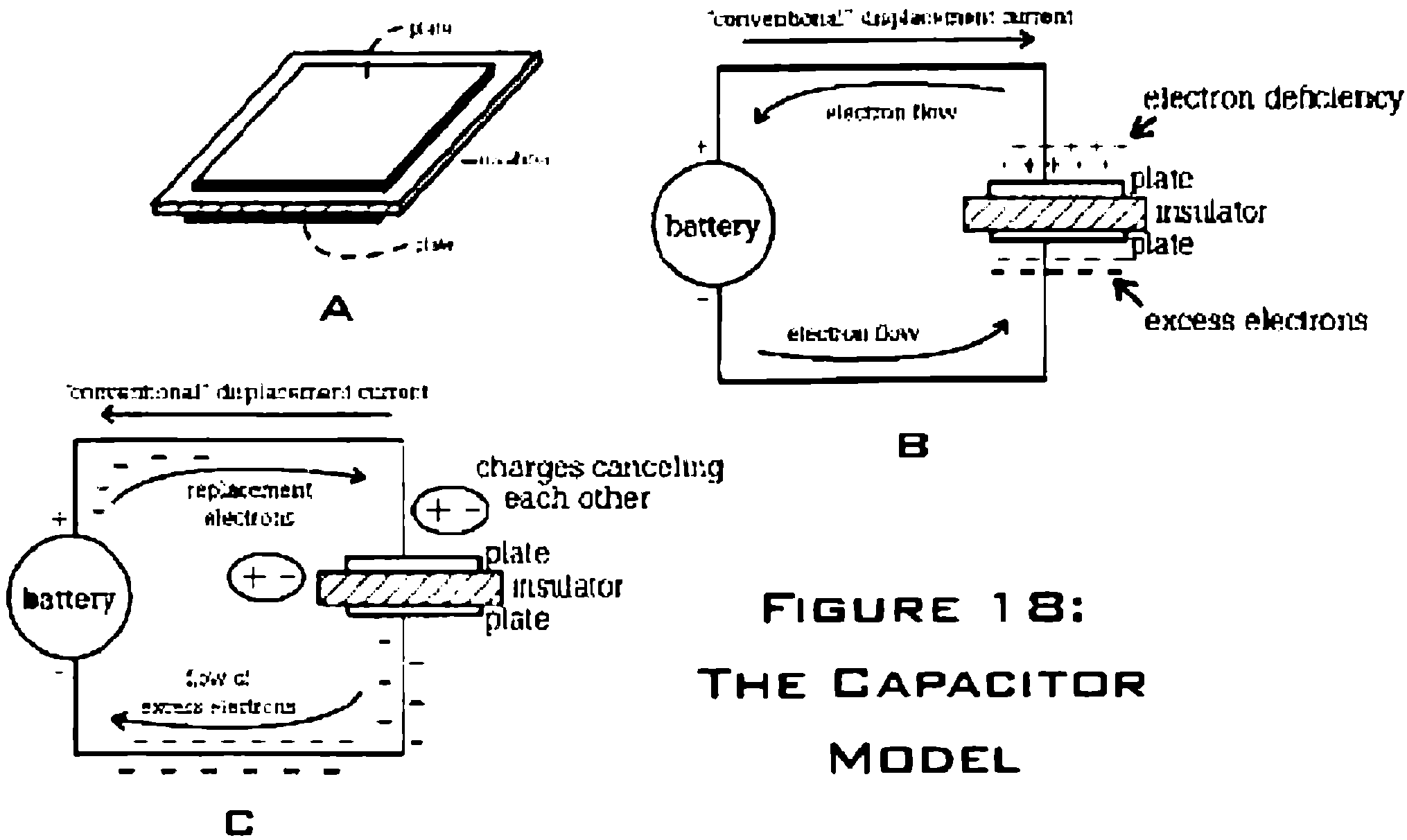
Figure: 18: The Capacitor Model
If you connect one side of a battery (say the negative “-”) to one of the plates and the other side of the battery to the other plate – as in fig. 18B – then the battery will try to push electrons through the capacitor. Since it’s not a complete circuit – because of the insulator – there will be no continuous current. But (…what! You’re surprised?…) a few (hundred, thousand, million, billion, etc., depending on the size of the plates) elecrons manage to get pushed in by the battery. These will eventually accumulate on the plate of the capacitor. We remember from Chapter 4, Static Electricity, that when you have an excess of charge – in this case electrons – then this forces electrons from the other plate (like charges repel, remember). So momentarily there is a brief current flowing. See figure 18C. Such a current is called a displacement current.
If these excess electrons go away, then electrons will rush back into the other plate. Yes, you’ll have another momentary current flowing in the opposite direction. See figure 18C.
 A capacitor is a “sandwich” that stores electrons on one piece of “bread.” The “filling” is the insulator.
A capacitor is a “sandwich” that stores electrons on one piece of “bread.” The “filling” is the insulator.You car see that if you connect the capacitor to an AC voltage – even though there is an insulator in the circuit – you’ll get a continuous AC current flowing in the circuit. See figures 18B and 18C. Notice here that the capacitor plates “store” excess electrons in an alternate fashion.
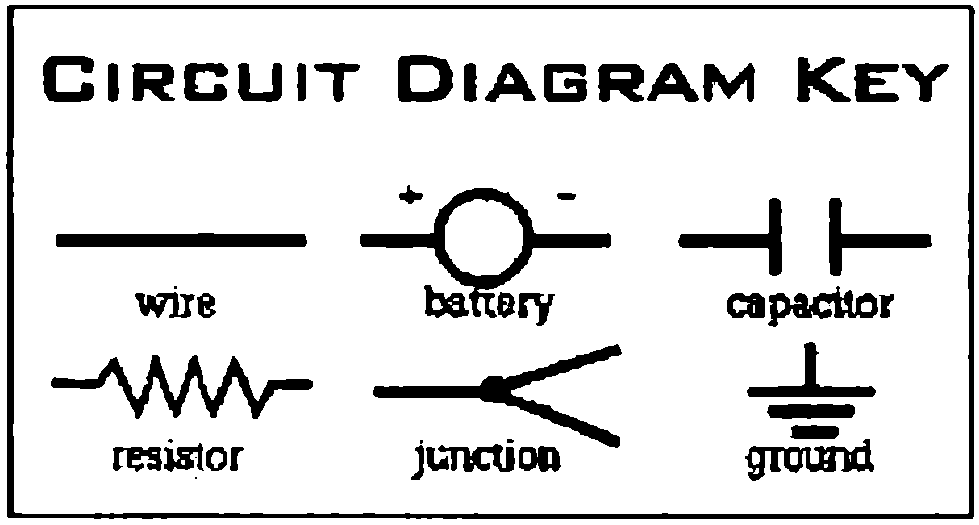
Capacitors have many uses in both DC and AC circuits. You use them, for example, if you want to block DC currents but pass AC currents. (Why is that so? You have all the information above to explain this. Think about it for a few moments.) But unless you’re designing electronic circuits, you needn’t concern yourself about the math involved in such design. This level of detailed knowledge of capacitors won’t be needed in understanding basic electrical play. Of course you may study this on your own.
Let’s expand the capacitor model a little bit
If you have a high-voltage toy like a violet wand, there is a transformer called a Tesla coil that generates a high voltage that goes to the metal part inside the gas tube. This high voltage is AC in nature.
Now think of this metal part inside the gas tube as one plate of the capacitor. One side of the Tesla coil power supply in the violet wand is connected to ground (see figure 19). Now wouldn’t you agree that the air surrounding the gas tube is an insulator? Yes? Good! But what would be the other plate of our extended capacitor model?

Figure 19: Capacitor Model of Violet Wand
Remember in our study of electrical safety (Chapter 7) that things like walls, tables, the sidewalk, whipping benches, etc. can be considered as ground. From the same chapter we remember that the power companies usually ground one side of their power system. This is the same ground to which the one side of the violet wand’s power supply, as well as the walls, etc., is connected.
Wallah! There is a complete AC circuit with the capacitor… excuse me… high voltage gas tube, air Insulator, and wall/floor/ceiling as the major circuit element. See figure 20.
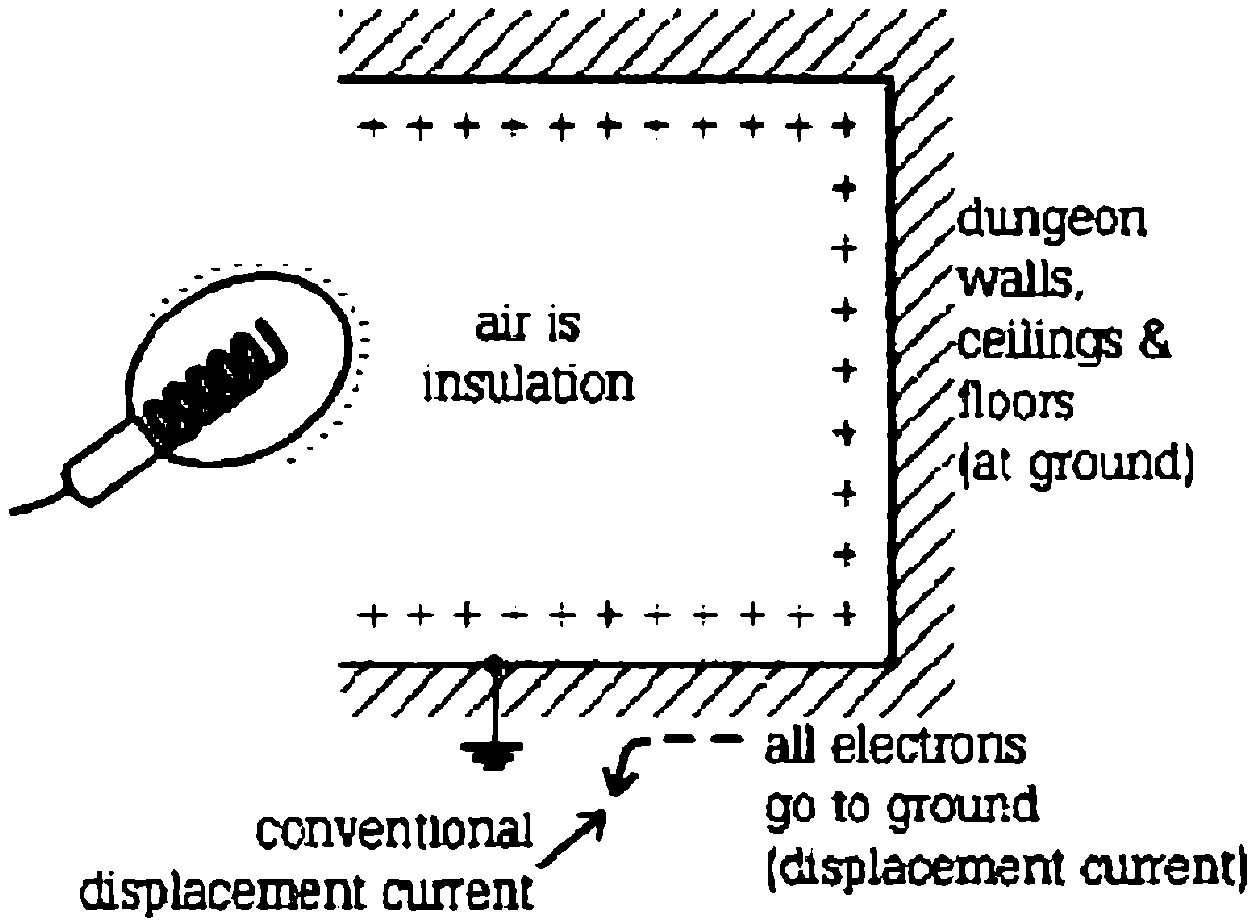
Figure 20
Now, what happens if you put a conducting body in the insulating air between the high voltage gas tube and the walls/floor/ceiling? The conducting body could be some bottom suspended by really good insulating ropes (most ropes, however, aren’t that good).

Figure 21
The resistance of the air is about 10,000,000-100,000, 000 ohms. The resistance of the suspended bottom is, say, about 1,000,000 ohms, but because of the insulation of the ropes, the bottom is still part of the insulation of the capacitor. Therefore no current will be running through the bottom.
But what about high frequencies, you ask? In other words is there action at a distance (see Chapter 6)?
The violet wand can generate very weak radio frequencies, especially when it sparks – but even at best, it’s not a very good radio transmitter. At the household frequency of 60 Hz (Hertz), there is very weak action-at-a-distance. So there will be hardly any high (or even low) frequency currents through the bottom – way below harmful levels.
So under these conditions, in figure 21, the bottom is not subjected to currents.
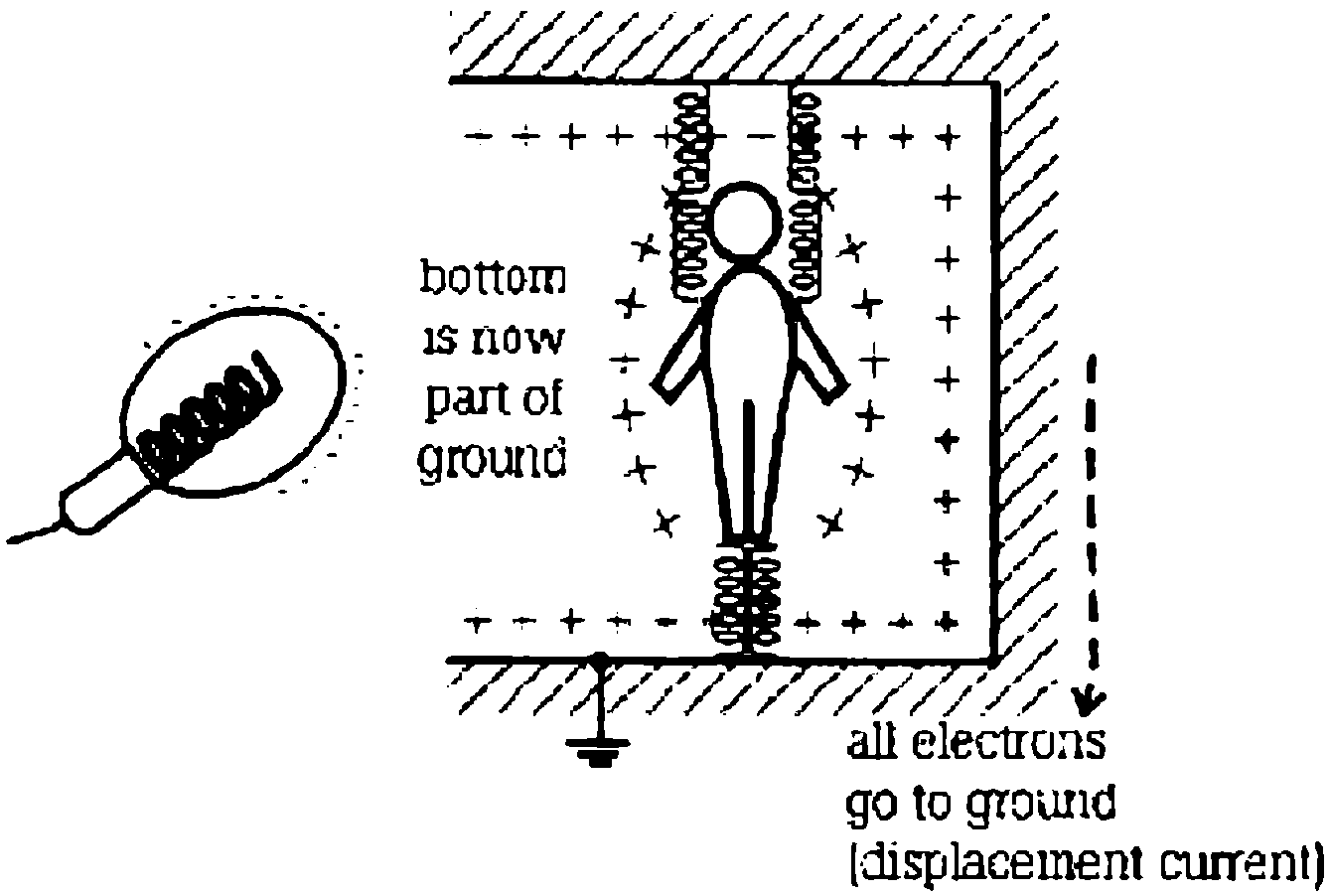
Figure 22
Now let’s take a more realistic situation. In this case the bottom is suspended with real-world ropes, or is lying on a bond- age table. For the purposes of this discussion, the bottom is connected to ground. In reality, because of the high voltages and the use of AC, you can consider the bottom to be connected to ground through many small capacitors (table legs, cuffs, etc.). This model is significant for violet wands, but not for considering currents through the bottom using TENS units or relaxicisers.
The bottom is now pan of one plate of a giant capacitor.
Will there be a current through the bottom? Yes, but very, very slight – almost nothing if the violet wand is far away.
Now let’s bring the violet wand close to the bottom’s skin – about a half inch, but not close enough to send out sparks. What the bottom feels is a sensation of ants crawling over his skin. We’ll discuss this feeling in more detail later, but for now let’s just say that it’s the result of electrons rushing to and fro over the surface of the bottom’s skin in an AC displacement current. See figure 22. Here the capacitor’s insulation is now the half inch of air, the glass tube, and the glowing gas inside the tube. This half inch of air is just beginning to reach the point where the air starts breaking down (see Chapter 6). The bottom can notice the displacement currents at this point.
 A violet wand acts as one plate of a capacitor, with the air around it as the “filling” and the bottom’s body as the other piece of “bread.”
A violet wand acts as one plate of a capacitor, with the air around it as the “filling” and the bottom’s body as the other piece of “bread.”As soon as you bring the violet wand’s gas tube to about 1/4 inch of the bottom’s skin, a spark will jump between the outer surface of the glass tube to the skin (see fig. 23). The air has now been converted to a conductor, and is carrying current to the bottom’s skin. The voltage difference from the glass surface at one end of the spark to the skin at the other end of the spark is about 25,000 volts Because AC is used, this voltage and current is alternating – however, in this model it works fine to think of it as DC. The insulation of our extended capacitor model is now only the glass of the tube and the gas inside.
The spark through the air meets a very high resistance – not as high as normal air, but still high. The other high resistances in the circuit are the skin, the gas in the tube, and the tiny capacitors connecting the table to the ground. Thus, the current inside the bottom’s body is very limited even though the voltages from the violet ward’s Tesla coil is high. Note that this very small current is continuous because of the equivalent capacitor model we’re using and because of the AC voltage that is involved.
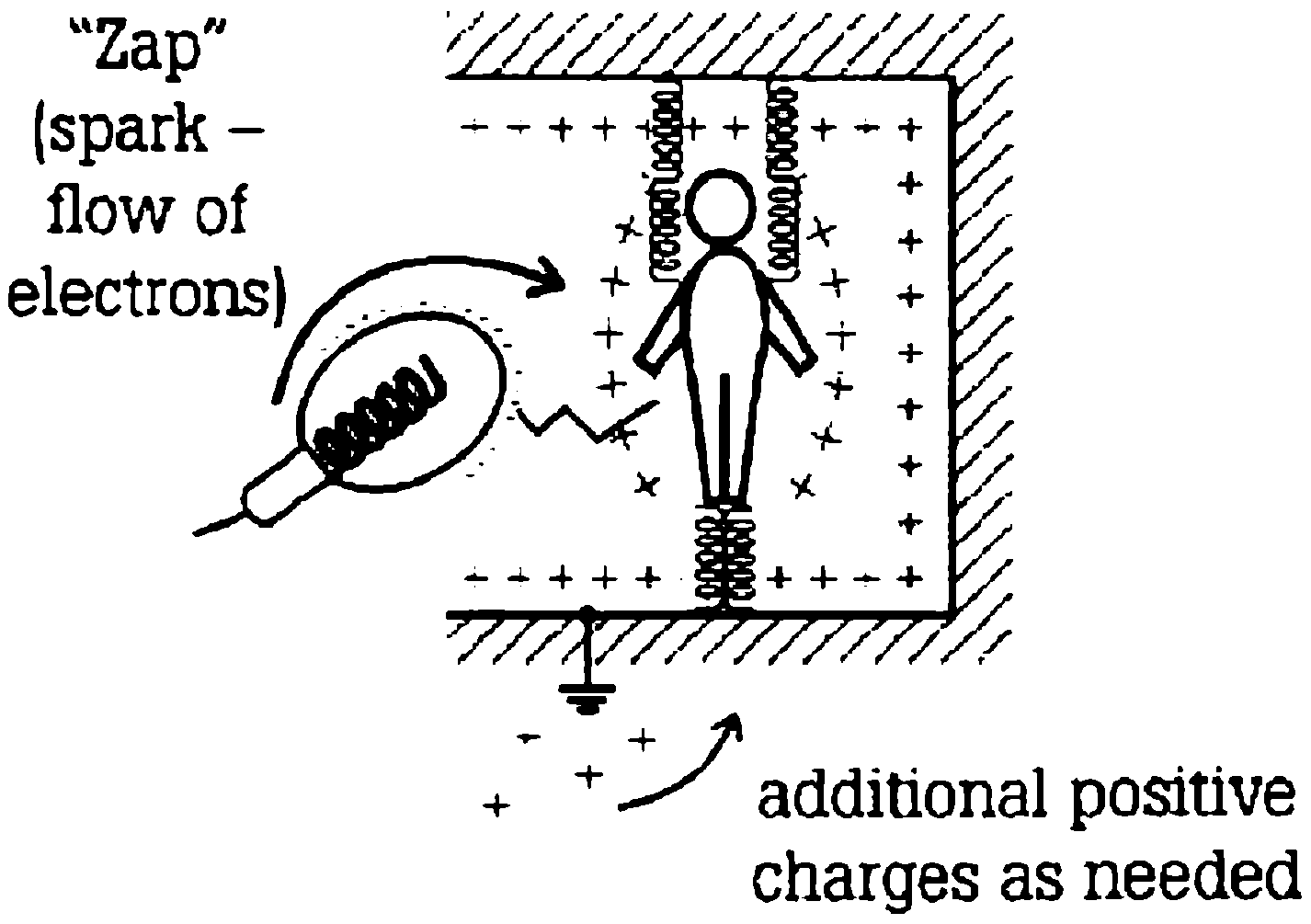
Figure 23
One consequence of this continuous current in the spark is that there is some minute heat produced. It’s not a lot of heat, but heat energy can accumulate or build up.
If this low heat energy spark were allowed to remain on one spot of skin for several minutes, you’d notice a small burn on the skin where the spark would touch. Depending on the body area you touch, this burn can be only an annoyance (if it were or the arm, for example) or quite painful (if it were on the clit or tip of the penis).
You also need to exercise caution with the heat from a violet wand spark as it has been known to set fire to flammable clothing. It is sometimes used to ignite 70% alcohol vapors for fire play.
Dave is an electrical engineer who designs computer hardware. Ann is a computer programmer. Dave and Ann are married. They have played together – including with electricity – for four years now. Dave bottoms to Ann and loves electrical cock and ball torture.
Dave and Ann ore both busy professional and do extensive business travel. When they’re separated, they miss each other and their play together.
Seeing as they were hath computer professional, they worked for a year on developing what they call their “travel kit.” Dave deigned the actual hardware. It was based on a TENS unit and a special penis and testicle stimulator in a rubber cock and ball sheath. Bat it is more, it can be controlled from the output of a laptop computer, and there are special safety features built in.
No one manufactures such a toy, so great care needed to be exercised in its design and construction. The major concern here was safety. There were special circuits to limit the current applied to the cock and balls. The question of what happened with the unit if the computer signal was lost had to be addressed.
They were successful with the device. Now Dave takes it with him whenever he or Ann are on a business trip.
First they agree – sometimes by E-mail – when they will play. Then using the internet and computer cameras and microphones on their laptops. Ann can watch Dave as he follows her orders to strip naked. He can see her in her leather corset, boots, and riding crop – just as if they were together.
Dave’s cock is already hard when Ann orders him to put on the device and to pat his bonds in the restraints. (He can quickly get out of these if necessary.) Now he is her slave, and she can watch it in real time.
With her syrupy voice cajoling him, Ann now manipulates a joy stick to control the location, intensity frequency, and duration of the series of shocks that Dave gets on his cock and balls.
Ann works Dave a couple of times to the point of cumming, hut doesn’t give him the coup de grace. “She’s such a sadist” Dave thinks happily as he moons and begs for release.
Another build up by Ann again. This time Dave knows that she’ll let him cum.
“Goodbye,” comes the mechanical voice from the computer.
“Loss of Carrier Signal, ” is the error message his computer reports as to why his computer was disconnected from the server.
“No, NO… Shit, ” Dave cries. A few choice curses about the server come from his mouth as he struggles to re-establish a connection. Has still horny and wants Ann to get him off.
“Damn, she’s actually smiling. The little sadist must he enjoying this.” Dave thinks as the connection is reestablished and Ann’s image and voice come on the screen. He humbly begs her to make him cum. This time she obliges and enjoys the sight of his spurting cum.
When they get together they’ll relive the experience, laugh, and possibly change servers. Then again, maybe they’ll replay it in their bedroom.
For those of you who’ve played with violet wands, sometimes – if the bulb s metal socket gets too near the bottom’s skin – a spark will jump from the socket to the bottom’s skin. The bottom will immediately notice that this spark seems more intense. It is. You’ve eliminated the high resistance of the gas and glass tube, but you still have the high resistances of the skin and the table capacitors. The current through the bottom s body is higher because of this, but it’s still limited by the remaining high resistances.
Generally this more intense spark is still within safe levels, but consider the current path that may exist through the bottom’s body. Also consider what things might be compromising the remaining high resistances. Is the bottom sweating profusely? Is the bottom bound in chains connected directly to a grounded wall? Is the grounding through a water pipe, which may cause lower resistance in the ground and higher resistance in the bottom’s body? If two or more of these compromises exist, you might have a hazardous current level in the body – particularly if the current path is near the heart area.
Now you can see how models can help you understand the play that you’re dealing with?
We already talked about the carpet shuffle zap in Chapter 6, but you can see that we can use the capacitor model again to take a look at it.
The person with the excess of electrons can be considered one plate of the capacitor, the intervening air the insulator, and the doorknob the other plate.
The electrons in this case are generated by simple friction of rubbing your feet across a carpet. This generates about a million or so electrons in your body. As you reach for the doorknob, the electrons in the doorknob are repelled away to ground because of like charges. This leaves you with two charged plates of a capacitor.
Again as your hand gets to about 1/4 inch of the doorknob, the voltage is high enough (25,000 volts) to break down the air. A spark results. In this case, however, it’s only a million or so electrons that constitute the current. Once they are gone, the current stops. This is not a continuous current like the sparking from a violet wand. It is strictly displacement currents.
Also, the extra electrons tend to accumulate on the surface of the skin. Thus the current that results from the spark would only be on the skin’s surface. The skin s resistance and the limited number of electrons would be enough to prevent a hazardous current inside the body.
What started off as a description of a couple of useful electrical devices ended up as another demonstration of how models can be useful in understanding the things you can play with. In fact we now have two models to be able to understand a simple electrical phenomenon – the carpet shuffle zap.
Let’s now take a look at some information you should know about human physiology.